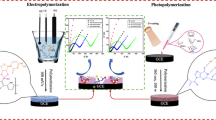Abstract
Combination of sacubitril, a novel neprilysin inhibitor, with valsartan, an angiotensin receptor blocker, was approved by FDA as first line treatment of chronic heart failure resulting from hypertension. A selective, rapid, accurate and precise stability indicating RP-HPLC method was developed for the estimation of sacubitril and valsartan in the presence of their impurities in bulk powder and pharmaceutical dosage form. Experimental design using face-centered composite design was applied during method optimization to achieve best resolution with minimum experimental trials. The two independent variables were buffer pH and organic modifier volume in the mobile phase. Chromatographic separation was accomplished using a Zorbax Eclipse C18 Cyano column (150 mm, 4.6 mm, 5 µm) and a mobile phase composed of ammonium acetate buffer (0.02 M, adjusted to pH 4 with acetic acid): acetonitrile (55:45, v/v) at a flow rate 1 mL min−1. Detection was performed at 254 nm. Sharp and well-resolved peaks for sacubitril and valsartan were obtained with retention times 4.91 and 2.53 min, respectively. A complete forced degradation of sacubitril was achieved and degradation kinetics under basic conditions was studied and was found to follow first-order kinetics. Structure elucidation was performed using mass spectrometry. The method was fully validated in terms of selectivity, linearity, accuracy, precision and robustness in agreement with ICH guidelines Q2 (R1).












Similar content being viewed by others
References
Solomon SD, Zile M, Pieske B, Voors A, Shah A, Kraigher-Krainer E, Shi V, Bransford T, Takeuchi M, Gong J, Lefkowitz M, Packer M, McMurray JJV (2012) The angiotensin receptor neprilysin inhibitor LCZ696 in heart failure with preserved ejection fraction: a phase 2 double-blind randomised controlled trial. Lancet 380(9851):1387–1395. doi:10.1016/S0140-6736(12)61227-6
Gu J, Noe A, Chandra P, Al-Fayoumi S, Ligueros-Saylan M, Sarangapani R, Maahs S, Ksander G, Rigel DF, Jeng AY, Lin TH, Zheng W, Dole WP (2010) Pharmacokinetics and pharmacodynamics of LCZ696, a novel dual acting angiotensin receptor—neprilysin inhibitor (ARNi). J Clin Pharmcol 50(4):401–414. doi:10.1177/0091270009343932
de Bold AJ (2011) Thirty years of research on atrial natriuretic factor: historical background and emerging concepts. Can J Physiol Pharm 89(8):527–531. doi:10.1139/y11-019
Ito S, Satoh M, Tamaki Y, Gotou H, Charney A, Okino N, Akahori M, Zhang J (2015) Safety and efficacy of LCZ696, a first-in-class angiotensin receptor neprilysin inhibitor, in Japanese patients with hypertension and renal dysfunction. Hypertens Res 38(4):269–275. doi:10.1038/hr.2015.1
Thürmann PA (2000) Valsartan: a novel angiotensin type 1 receptor antagonist. Expert Opin Pharmacother 1(2):337–350. doi:10.1517/14656566.1.2.337
Criscione L, Bradley WA, Bühlmayer P, Whitebread S, Glazer R, Lloyd P, Mueller P, Gasparo M (1995) Valsartan: preclinical and clinical profile of an antihypertensive angiotensin II antagonist. Cardiovasc Ther 13(3):230–250. doi:10.1111/j.1527-3466.1995.tb00305.x
Vardeny O, Miller R, Solomon SD (2014) Combined neprilysin and renin-angiotensin system inhibition for the treatment of heart failure. JACC Heart Fail 2(6):663–670. doi:10.1016/j.jchf.2014.09.001
Vilela-Martin JF (2016) Spotlight on valsartan–sacubitril fixed-dose combination for heart failure: the evidence to date. Drug Des Dev Ther 10:1627
Chunduri RH, Dannana GS (2016) Development and validation of a reliable and rapid LC-MS/MS method for simultaneous quantification of sacubitril and valsartan in rat plasma and its application to a pharmacokinetic study. Biomed Chromatogr 30(9):1467–1475. doi:10.1002/bmc.3707
Patel KH, Luhar SV, Narkhede SB (2016) Simultaneous estimation of sacubitril and valsartan in the synthetic mixture by RP-HPLC method. J Pharm Sci Biosci Res 6(3):262–269
Naazneen S, Sridevi A (2017) Development of assay method and forced degradation study of valsartan and sacubitril by RP-HPLC in tablet formulation. Int J App Pharm 9(1):9–15
Miller JN, Miller JC (2010) Statistics and chemometrics for analytical chemistry, 6th edn. Pearson education Limited, England, pp 186–216
Deming SN, Morgan SL (1993) Experimental design: a chemometric approach, 2nd edn. Elsevier Publishers, Amsterdam, pp 151–169 (227–274)
Entresto-Novartis Pharmaceuticals Corporation (2015) Highlights of prescribing information. https://www.pharma.us.novartis.com/sites/www.pharma.us.novartis.com/files/entresto.pdf. Accessed 22 Apr 2017
Minitab®, Version 17, Statistical Software; Minitab, Inc.: State College, PA, USA, 2014. (2014). Version 17 edn, State College, PA, USA
El-Zaher AA, Mahrouse MA (2013) A validated spectrofluorimetric method for the determination of nifuroxazide through coumarin formation using experimental design. Chem Cent J 7(1):1–12. doi:10.1186/1752-153X-7-90
El-Zaher AA, Mahrouse MA (2013) Utility of experimental design in pre-column derivatization for the analysis of tobramycin by HPLC—fluorescence detection: application to ophthalmic solution and human plasma. Anal Chem Insights 8:9–20. doi:10.4137/ACI.S11612
Commission of the European Communities (1996) Q2 (R1) Validation of analytical procedures: text and methodology. In: Proceedings of the international conference on harmonisation (ICH) of technical requirements for registration of pharmaceuticals for human use, Geneva (incorporated in 2005)
Khamanga SM, Walker RB (2011) The use of experimental design in the development of an HPLC–ECD method for the analysis of captopril. Talanta 83(3):1037–1049. doi:10.1016/j.talanta.2010.11.025
The United States Pharmacopeia (USP 34), National Formulary (NF 29), 20011, Rockville, MD
Montgomery DC (2008) Design and analysis of experiments, 7th edn. John Wiley & Sons Inc, Asia, pp 1–22 (60–114, 207–263)
Blessy M, Patel RD, Prajapati PN, Agrawal YK (2014) Development of forced degradation and stability indicating studies of drugs—a review. J Pharm Anal 4(3):159–165. doi:10.1016/j.jpha.2013.09.003
Bruckner R (2001) Advanced organic chemistry: reaction mechanisms, 1st edn. Academic press, San Diego
Sudesh BM, Uttamrao KS (2009) Determination and validation of valsartan and its degradation products by isocratic HPLC. J Chem Metrol 3(1):1–12
Berry RS, Rice SA, Ross J (2001) Physical and chemical kinetics, 2nd edn. Oxford University Press, Oxford
Upadhyay SK (2007) Chemical kinetics and reaction dynamics, 1st edn. Springer, Amsterdam. doi:10.1007/978-1-4020-4547-9
Wright MR (2004) Introduction to chemical kinetics. Chichester, UK
Drug stability and kinetics. https://www.scribd.com/doc/76640703/Drug-Stability-and-Kinetics. Accessed 29 March 2017
Author information
Authors and Affiliations
Corresponding author
Ethics declarations
Conflict of interest
The authors declare that they have no conflict of interest.
Ethical approval
This article does not contain any studies with human participants or animals performed by any of the authors.
Rights and permissions
About this article
Cite this article
Moussa, B.A., Hashem, H.M.A., Mahrouse, M.A. et al. Experimental Design Approach in HPLC Method Development: Application for the Simultaneous Determination of Sacubitril and Valsartan in Presence of Their Impurities and Investigation of Degradation Kinetics. Chromatographia 81, 139–156 (2018). https://doi.org/10.1007/s10337-017-3425-9
Received:
Revised:
Accepted:
Published:
Issue Date:
DOI: https://doi.org/10.1007/s10337-017-3425-9




